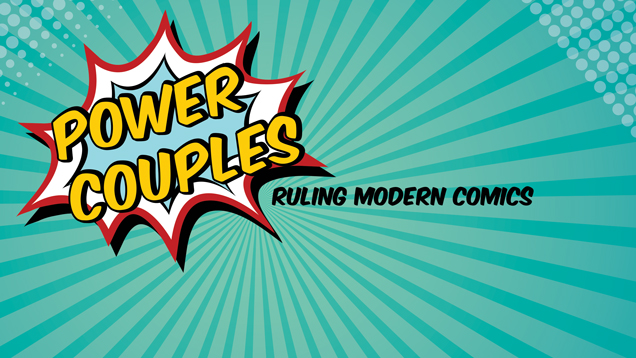Power Couples: Ruling Modern Comics
 CREDIT: CANDIS BROSS
CREDIT: CANDIS BROSSJerrold Rundle takes a look at what's going on in the super hero love game.
Throughout the ages there have always been power couples, Lois Lane and Clark Kent (Superman), Susan Storm and Reed Richards (Fantastic 4), not to mention the infamy of Jean Grey and Scott Summers' (X-Men) multiple relationships; super powered partnerships have graced the pages of comics for decades.
But these are the known couples, the duos we all see and hear about in movies. What about comics today? Even with the rather accurate view that the industry disdains major change, modern comics are actually bucking those trends. So what's going on in the super hero love game? Be warned, MEGA SPOILERS are involved in the following paragraphs.
Alana and Marko
Where to start? It's a forbidden love, one told countless times, pretty much a goddamned Romeo and Juliet. Alana, a soldier-turned-prison guard in a totally messed up interstellar war between hi-tech winged humans from Landfall and magically enabled horned humans from its moon Wreath, while Marko is one of those prisoners Alana's tasked with patrolling. It's a lot of political baggage from the start.
The actual comic is about their child, Hazel. The pair had to go on the lam with the newborn, being hunted across the universe by bounty hunters with a lying cat and interstellar governments, all out for the child's head. Why? The idea that two warring interstellar bodies can find common ground, let alone having their citizens love each other is unfathomable. It's a wild ride with a TV head robot prince playing porn on his screen and a spider-bodied woman out to collect the prize on young Hazel and her parent's heads.
Midnighter and Apollo
The modern day take on the superman/batman duo, this couple has been out kicking super villains to the curb since Warren Ellis created The Weatherman in 1998. Though the two originally came from a twisted experimental team and were the only survivors, eventually they found love and got married, adopting daughter Jenny Quantum, the clone of their original team leader Jenny Sparks.
Both Midnighter and Apollo were brought into DC's publishing initiative, The New 52, as a non-couple, although they eventually discovered their mutual attraction for one another by the series' end. More recently, Midnighter was written as a single, sexually open crime fighter, even taking time to use the gay dating app Scuff. Unfortunately, this means Apollo and Midnighter are no longer married, at least for now.
Kate Kane and Renee Montoya
Imagine being a detective and knowing the love of your life is out making your job quite a bit easier, but doing so illegally, by being the best vigilante possible? For Renee, a former Gotham detective who eventually resigned due to the corruption plaguing the Gotham, this is a reality.
Eventually she became The Question, taking the name after the original vigilantes death, but during that time she also developed a serious relationship with Kate Kane (Batwoman). Readers might find it ironic that Batwoman, who was eventually written as a lesbian, originally appeared in Detective Comics in 1956 to dispel the rumours that Batman and Robin were gay.
Since then she's become one of DC's more controversial characters, in part due to the series behind-the-scenes drama. Despite DC nixing the wedding due to the belief that super heroes shouldn't have happy personal lives, the series has been the recipient of several praises for its accurate portrayal of a lesbian relationship, though it's currently shelved.
Scott Pilgrim and Ramona Flowers
Scott Pilgrim vs. the World is about a total slacker/ indie bassist having to defeat seven, technically eight, evil exes in order to date Ramona Flowers, a rollerblading parcel delivery girl who travels through subspace bridges inside Scott's dreams. Set in real-world Toronto, readers are treated to a race through Honest Ed's, brawling under the backdrop on Castle Loma, and an indie music show at Lee's Palace. After fixing major relationship screw-ups, Scott goes on to defeat DJ's, a Bollywood dancing villain and a giant crystal preservation machine. In the series ending, Ramona and Scott hold hands and step into a new life and subspace bridges together.
Clones New-Father John and Parabalani “Greenknife” John
Beginning in a bathhouse for leaders of the Terran Empire, the pairing of Greenknife, simply named a Parabalani (or pleasure caste) and New-Father John, a newly awakened leader caste clone, is a violent one. Greenknife saves New-Father John's life, earning his name in the process. The whole comic is confusing, strange and visually stunning. After Greenknife saves New-Father from the alien assassin, the two stay together throughout the remainder of Prophet until New-Father John's stomach-churning, cosmos-changing death in the series' final arc.
In later scenes, a malevolent sonic force from before the universe's creation uses their relationship to gain access into Parabalani John's mind, willing the young clone to believe his partner is still alive, almost dooming the young clone and his teammate in the process.
This only scratches the surface of relationships in comics today. While the Big Two are getting their acts together over 15 years, Image, Dark Horse and indie publishers worldwide have been at it much longer, depicting real and honest relationships for decades, although to be fair, some credit has to go to Marvel. After all, Marvel did write the trans-species pairing of robotic entity the Vision and reality warping Scarlet Witch back in the ‘70s, even giving the super villain-fighting couple children of their own to love and care for, Marvel's version of the nuclear family.














